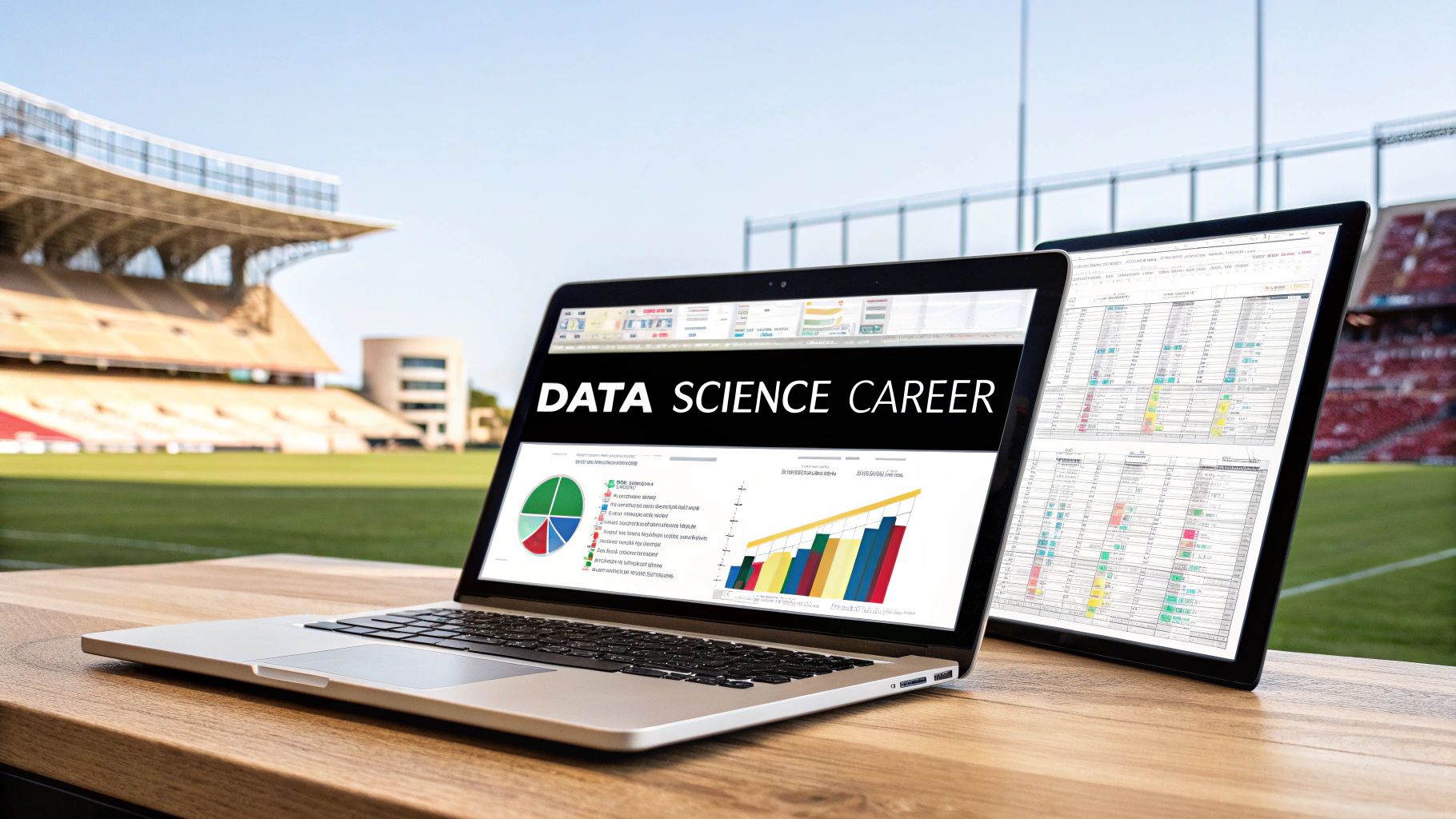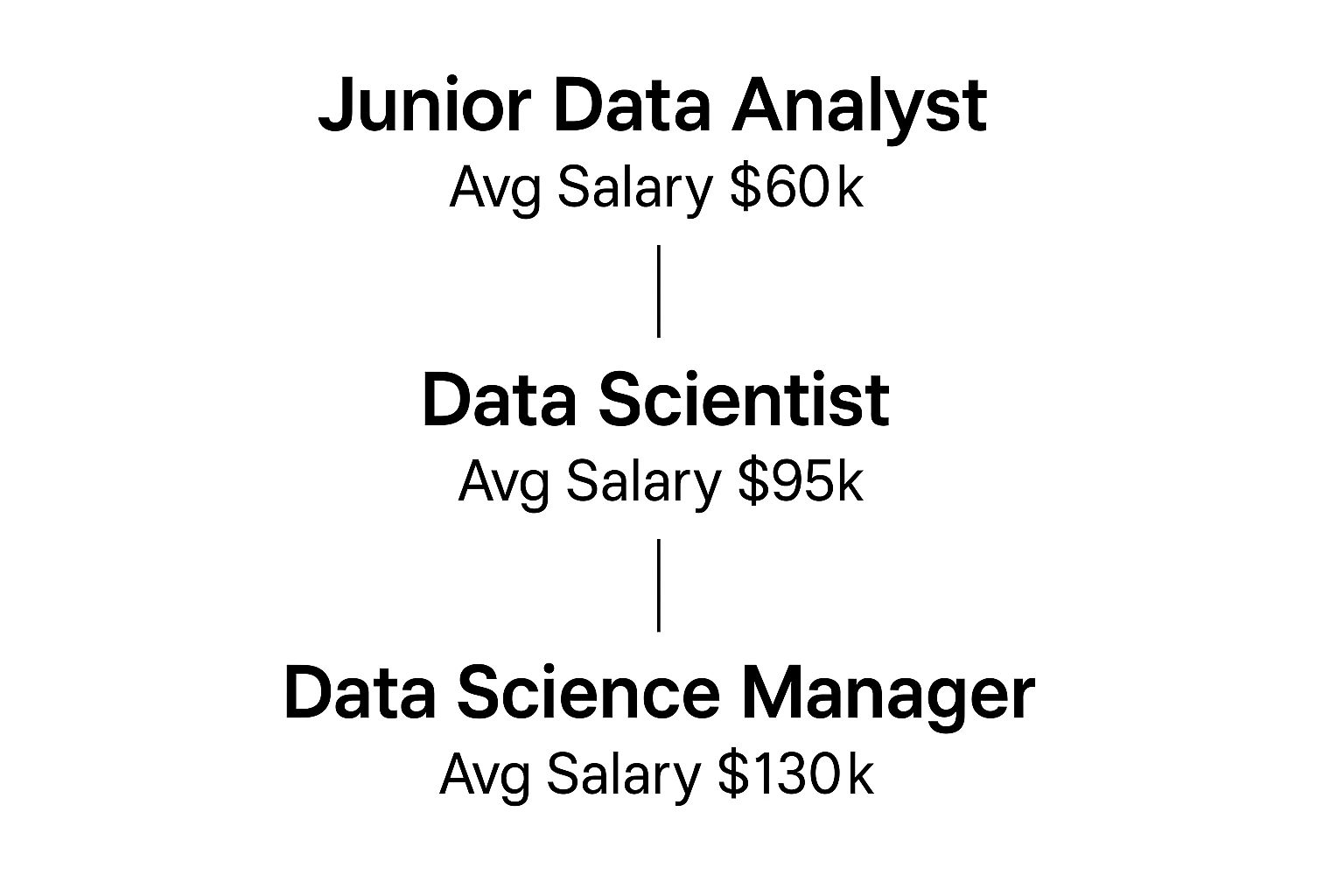
Your Data Science Career Path to Success
A career in data science isn't a rigid ladder but more of a flexible journey, starting with hands-on analysis and potentially leading all the way to strategic leadership. You'll typically start out as a Data Analyst, move into a Data Scientist role, and from there, you can branch out into senior specializations or management. Naturally, the pay and responsibility ramp up with each step.
Your Roadmap to a Data Science Career
Thinking about a data science career? It’s like setting out on an expedition into one of the most exciting fields out there right now. This roadmap will give you a clear lay of the land, showing you what the journey looks like from your first day as a junior analyst to your future as a principal data scientist. Think of it as your compass for navigating the path ahead.
The demand for these roles isn't just strong—it's exploding. Projections show that data science jobs are expected to grow by about 35% between 2022 and 2032, which is way faster than most other professions. This boom is all thanks to industries everywhere trying to get smarter with their data, creating a massive need for people who know what they're doing. You can dig deeper into career trends and the skills in demand.
Navigating the Core Career Milestones
The path is pretty logical, with each role building on the skills of the last. At first, your main job is to get good at handling and analyzing data. As you gain more experience, you’ll shift your focus to building predictive models and, eventually, to leading strategy and entire teams.
You can really boil it down to three main stages, each with its own set of responsibilities and earning potential. This visual breaks down the typical hierarchy and what you can expect to earn as you climb.

As you can see, there's a big jump in both what's expected of you and what you get paid as you move from an analyst to a manager. It’s a clear and valuable career ladder to climb.
A very common path starts with a Data Analyst role, where you're focused on reporting and cleaning up messy data. After 2-5 years, you can level up to a Data Scientist position and start building predictive models. From there, you can either go deep into the technical side as a Principal Data Scientist or move into people management as an Analytics Director.
To give you a clearer picture, I've put together a table that summarizes the key milestones, how much experience you'll need, and the typical salary you can expect at each level.
Data Science Career Stages at a Glance
This table breaks down the typical progression, experience levels, and salary expectations for key roles within the data science career path.
| Career Stage | Typical Roles | Years of Experience | Average Salary Range |
|---|---|---|---|
| Entry-Level | Junior Data Analyst, BI Analyst | 0-3 years | $55,000 - $80,000 |
| Mid-Level | Data Scientist, Data Engineer | 3-7 years | $90,000 - $135,000 |
| Senior-Level | Senior Data Scientist, ML Engineer | 5-10+ years | $130,000 - $180,000 |
| Leadership | Data Science Manager, Director of Analytics | 8-15+ years | $170,000 - $250,000+ |
This quick guide should give you a practical, at-a-glance understanding of where your career could go and what it takes to get there.
Building Your Foundational Data Science Skills

Every great data scientist I've ever met built their career on a rock-solid foundation of skills. This isn’t about just ticking boxes on a resume. It’s about deeply understanding why each piece matters and how they lock together to find those game-changing insights. A real data science career path is a mix of technical chops and smart, strategic thinking.
Think of it like building a house. Your math and stats knowledge is the concrete foundation. Programming languages are the frame that gives it structure. And your sports knowledge? That's the interior design that makes the whole thing useful and valuable. If you skip any of these, the entire structure gets wobbly.
The Concrete Foundation: Math and Statistics
At its core, data science is just applying the scientific method to solve problems—in our case, sports problems. It all starts with math and statistics. These are the rules that prove your work is legitimate. You don't need a Ph.D. in pure mathematics, but a solid, practical grasp of the key ideas is non-negotiable.
Here’s what you absolutely need and why:
- Probability: This is all about understanding the likelihood of things happening. It's the bedrock of any predictive model you'll ever build.
- Linear Algebra: It might sound intimidating, but this is just the language for working with datasets, which are basically just big grids of numbers (matrices and vectors).
- Calculus: Ever wonder how a machine learning model "learns"? Calculus concepts like gradient descent are the engine that drives that process.
- Statistical Analysis: This is how you design good experiments (like A/B testing a new fan engagement strategy), check if your ideas hold water, and make sure your results aren't just a fluke.
This foundation ensures your conclusions are sound and your models are reliable. It’s the difference between a lucky guess and a data-backed prediction. Without it, you’re flying blind.
The Framework: Programming and Databases
So, you have a question you want to answer. Now you need the tools to actually test it. Programming is how you tell a computer to grab, clean, analyze, and visualize data on a scale that's impossible for a human to do by hand. It’s the framework that brings your analytical ideas to life.
While there are a ton of languages out there, a couple of them are central to almost every data science job you'll find.
Key Insight: Look, while dozens of tools exist, mastering Python and SQL is your most direct path to being effective. These two pop up in over 70% of data science job postings and are the absolute core of the modern data toolkit.
Structured Query Language (SQL) is the universal language for pulling data from organized databases. You'll use it every single day to grab the specific slices of information you need. For example, you might use SQL to pull a player's shooting stats, but only for away games in the fourth quarter.
Python has completely taken over as the go-to language for data science. It’s relatively easy to learn and has an incredible ecosystem of free libraries like Pandas (for messing with data tables), NumPy (for number crunching), and Scikit-learn (for building machine learning models). It’s the Swiss Army knife you'll use for everything.
The Interior Design: Domain Expertise
This is the final piece, and honestly, it's the one most people overlook: domain expertise. This is your deep understanding of the sport you're working in. It’s the context that turns raw numbers into a winning strategy. A model that predicts player fatigue with 95% accuracy is totally useless if you don't understand what actually makes players tired in a real game.
For a career in sports analytics, this means you need to know the game inside and out.
- What are the most important stats (KPIs) for a point guard versus a center in basketball?
- How do different ticketing and sponsorship deals actually make money for a team?
- What on-field events have the biggest impact on a team's chances of winning?
This knowledge is what lets you ask the right questions in the first place. It helps you interpret the results correctly and, most importantly, explain your findings in a way that coaches, GMs, and scouts will actually listen to. It’s what makes you a strategic partner, not just a tech guy who runs the numbers. This trifecta—math, code, and sports knowledge—is your blueprint for success.
Navigating Your First Data Science Roles
Once you've got a solid handle on the basics, the next big step is landing that first role. This is where all the theory you've been learning smacks right into the real-world pressures of a sports organization. The job market can feel like a maze at first, with a bunch of titles that sound the same but mean totally different things day-to-day.
Let's cut through the noise and break down the three most common roles you'll run into: the Data Analyst, the Data Scientist, and the Data Engineer.
Think of it like building a house. The Data Engineer is the one laying the foundation and installing all the plumbing and electrical wiring. They make sure everything flows smoothly and reliably. The Data Analyst then comes in to read the meters, check usage patterns, and report on what's happening. Finally, the Data Scientist takes that information to predict future needs and figure out how to make the whole house run more efficiently.
The Storyteller: The Data Analyst
The Data Analyst is basically the team's historian and journalist. Their main gig is to sift through past data and answer the question, "What happened?" They're the pros at taking a mountain of messy, raw numbers and turning it into clean reports and dashboards that help the higher-ups make smart calls.
A typical day for an Analyst might look something like this:
- Digging into Databases: Firing up SQL to pull specific info, like ticket sales data from the last quarter.
- Data Janitor Duty: Finding and fixing all the weird inconsistencies in a dataset. It’s not glamorous, but it’s critical for making sure the information is trustworthy.
- Making Data Pretty: Building charts and graphs in tools like Tableau or Power BI to visualize trends, like which marketing campaign actually got fans excited.
- Translating for the Masses: Boiling down all their findings into a simple summary for folks who don't speak "data," like the marketing department.
Analysts are the bedrock of the team. They find the important signals hidden in all the noise, giving everyone else the context they need to do their jobs.
The Fortune Teller: The Data Scientist
While an Analyst looks back, a Data Scientist is all about looking forward. Their job is to answer the big questions: "What's going to happen next, and what should we do about it?" They pull from their bag of tricks in statistics and machine learning to build models that predict the future.
A Data Scientist takes the clean, organized data from the analysts and engineers and uses it to forecast what’s coming. For instance, a team’s data scientist might create a model to predict a player's injury risk based on their game-time workload and biometric data. This isn't just a cool exercise; it lets coaches be proactive about resting players to keep them healthy.
You can see this kind of work in action in roles like this Data Scientist position for a sports organization, where predictive modeling has a direct impact on game-day strategy.
Key Takeaway: The real jump from Analyst to Scientist is the shift from describing what happened to predicting what will happen. That leap means you need a much stronger command of programming (usually Python), statistics, and machine learning.
The Architect: The Data Engineer
Let's be clear: behind every great analyst and scientist, there’s an even greater Data Engineer. This is the unsung hero of the data world. Their job is to design, build, and maintain the massive systems that actually collect, store, and process all the data. They answer the question, "How do we get clean, reliable data to the right people without everything breaking?"
Data Engineers are the architects. They build the data "pipelines" that move information from all over the place—stadium sensors, ticketing sites, mobile apps—into one central spot where it's ready for analysis. They obsess over making sure these systems are tough, can handle huge amounts of data, and are locked down tight.
Frankly, without them, nobody else has any data to work with. It's a foundational role, and a critical one.
Choosing Your Advanced Career Specialization

Once you've got a solid handle on the data scientist role, you'll find the path isn't just a straight line forward. It splits into several exciting roads, each letting you dive deeper into what really gets you fired up. Do you love the nitty-gritty technical puzzles? The big-picture strategy? Or building smart systems from the ground up? This is where you graduate from a generalist to a specialist, and your impact—and value—skyrockets.
Think about it like this: your family doctor is a lifesaver, but for a complex heart issue, you need a cardiologist. It's the same in sports analytics. As teams and organizations get more sophisticated with data, they need experts who can tackle very specific, high-stakes problems. Picking a specialization is your shot at becoming that go-to person.
The Technical Master: The Machine Learning Engineer
If building predictive models is your favorite part of the job and you want to see them come to life, then the Machine Learning (ML) Engineer role is your next logical step. This isn't about running one-off analyses anymore. It's about building, deploying, and maintaining the automated ML systems that work at scale.
A data scientist might cook up a prototype model to predict player fatigue. The ML Engineer is the one who takes that recipe and turns it into a robust, real-time app the coaching staff can actually use on the sidelines. Their world revolves around scalability, performance, and reliability.
Their day-to-day often involves:
- Building Data Pipelines: Creating the automated plumbing that keeps clean, fresh data flowing into your models.
- Model Deployment: Using tools like Docker, Kubernetes, and cloud platforms (think AWS, GCP, or Azure) to get models out of the notebook and into the real world.
- Monitoring and Maintenance: Keeping a close watch on model performance over time and retraining them as new data rolls in.
This path demands serious software engineering chops to go along with your data science skills.
The Innovator: The AI Specialist
A close cousin to the ML Engineer is the AI Specialist. This role usually goes a step further into the deep end of the pool, exploring advanced and sometimes experimental fields like deep learning, natural language processing (NLP), or computer vision. While an ML Engineer might focus on deploying proven solutions, an AI Specialist is often tasked with pioneering new ones.
For instance, an AI Specialist at a sports media company could build a computer vision system that automatically chops up game footage into highlight reels. Or they might use NLP to sift through thousands of fan tweets to measure sentiment after a soul-crushing loss.
An AI Specialist is working on stuff that often feels like it's pulled from the future. They're the ones pushing the limits, which requires a deep command of frameworks like TensorFlow or PyTorch and an insatiable appetite for learning.
The Leader: The Analytics Manager
Look, not everyone wants to spend their career buried in code. If you find yourself drawn to strategy, mentoring a team, and having a seat at the decision-making table, then the Analytics Manager or Data Science Manager path might be calling your name. This is a deliberate pivot from hands-on work to leading people and projects.
An Analytics Manager guides a team of analysts and scientists. They're responsible for setting the team's vision, making sure data projects align with the organization's goals, and translating complex findings into clear, strategic advice for the top brass. A great example of how these skills merge is the Senior Product Analyst role, which sits right at the intersection of deep analysis and business leadership.
Your success here isn't measured by model accuracy, but by your team's success and its tangible impact on the organization's goals.
Comparing Advanced Data Science Specializations
To help you figure out which path feels right, I've put together a quick comparison of these advanced roles. Think about what kind of projects excite you and what skills you enjoy using most.
| Role | Primary Focus | Key Technical Skills | Typical Project Example |
|---|---|---|---|
| ML Engineer | Productionizing models | Cloud platforms, Docker, Kubernetes, data pipelines | Deploying a real-time player performance prediction system for in-game use. |
| AI Specialist | Research & Development | Deep learning, NLP, computer vision, TensorFlow, PyTorch | Creating a system to auto-generate game highlights from broadcast footage. |
| Analytics Manager | Strategy & Leadership | Project management, communication, business acumen | Guiding a team to analyze fan engagement data to inform a new marketing strategy. |
Each of these paths offers a unique way to shape the future of sports. The key is to choose the one that aligns not just with your skills, but with what you're truly passionate about building, leading, or discovering.
The Future of Data Science Careers
 With all the talk about AI and automation, I get it. It's easy to wonder if a data science career path is still a safe bet. Is the field getting too crowded? Will some new tool make your job obsolete?
With all the talk about AI and automation, I get it. It's easy to wonder if a data science career path is still a safe bet. Is the field getting too crowded? Will some new tool make your job obsolete?
The short answer is no, but things are definitely changing.
The role isn't disappearing; it's evolving. The old-school data scientist—a generalist who did a bit of everything—is giving way to a sharper, more strategic specialist. Think of it less like a factory worker getting replaced by a robot and more like a skilled woodworker getting a set of power tools.
The boring, repetitive stuff, like basic data cleaning or churning out the same old reports? That's increasingly being handed off to automated systems. This doesn't make data scientists less important; it actually makes them more valuable.
It frees you up to focus on the things we humans do best: asking smart questions, thinking critically about really tough problems, and turning raw data into a real-world game plan for the business. The future belongs to the data scientist who can be a strategic partner, not just a technical expert on call.
Key Trends Shaping Tomorrow's Data Scientist
A few big trends are steering the ship here. If you're planning a long-term career in this space, you need to know what they are. These aren't just buzzwords; they're major shifts in how companies operate and what they'll pay top dollar for.
Two of the biggest ones you need to have on your radar are:
- The Rise of MLOps: This is short for Machine Learning Operations. It's all about the practical side of taking a model out of the "lab" and making sure it runs reliably in the real world. This isn't just data science; it's a mix of software engineering and operations skills needed to build, monitor, and manage the entire lifecycle of a model.
- The Demand for Ethical AI: As AI starts making more critical decisions, things like fairness, transparency, and accountability are non-negotiable. Future data scientists have to build models that are not only accurate but also fair and explainable, ensuring they don't accidentally amplify harmful biases.
The core of the job is shifting. It's moving away from just building a cool model to making sure that model is effective, reliable, and responsible when it's actually out there doing its job. This requires a much more holistic, business-savvy mindset.
A Data-Backed Look at Longevity
Worries about the market getting saturated are understandable, but the data tells a much different story—one of growth and high demand. The industry is just maturing, which means it's placing a higher value on real expertise and specialized skills.
The data science career path isn't just surviving; it's thriving.
In 2025, job postings requiring a data science degree jumped from 47% to 70% in a single year. That’s a massive signal that companies are looking for more qualified pros, not fewer.
Even better, the average salary for an entry-level data scientist shot up by $40,000 to $152,000 during that same time. The bar is getting higher, but the rewards are growing even faster for those who can clear it. For a deeper dive, you can check out the complete data science job outlook.
At the end of the day, investing in a data science career path is still one of the smartest moves you can make. The field isn't shrinking; it's specializing. If you focus on critical thinking, strategic problem-solving, and get up to speed on trends like MLOps and ethical AI, you'll be building a career that's not just valuable, but future-proof.
Common Questions About the Data Science Career Path
When you're trying to break into data science, or figure out your next step, a few questions always seem to pop up. Let's cut through the noise and get you some straight answers so you can focus on what really matters.
What Does a Typical Career Progression Look Like?
Most people get their start in a Data Analyst role. This is where you learn the ropes—cleaning up messy data, running reports, and figuring out what happened in the past. It’s the foundation.
After you've put in 2-5 years proving you can find real insights in the data, you’ll likely be ready for a Data Scientist position. This is where you shift from explaining the past to predicting the future with models and forecasts.
From there, your path can really start to branch out:
- You might become a Principal Data Scientist, the technical guru who everyone turns to for the toughest modeling challenges.
- You could move into a leadership role like Analytics Director, where you're managing the team and setting the strategy.
- Or you could specialize as a Machine Learning Engineer, focusing entirely on building and deploying sophisticated models that run at scale.
How Much Math Do I Actually Need?
Look, you don't need a Ph.D. in theoretical mathematics. What you do need is a practical, working knowledge of the key concepts. Think of math and stats as your quality control—they’re what make your work solid and your conclusions believable.
You’ve got to have a good handle on fundamentals like linear algebra, probability, and statistics. This isn’t about rote memorization. It’s about understanding why an algorithm works the way it does, how to properly check your models for accuracy, and how to run an A/B test that actually tells you something useful. In the real world, that applied skill is worth way more than knowing abstract theories.
Can I Get a Job in Data Science Without a Specific Degree?
Absolutely. A computer science or stats degree is great, but it’s definitely not the only way in. I've met fantastic data professionals who studied everything from physics and economics to biology and social sciences.
What really matters to employers is whether you can do the work. The best way to prove that isn't with a piece of paper, but with a portfolio full of projects that solve real problems. Getting hands-on experience, even through something like a social impact internship exploring community engagement, speaks volumes. It shows you have the initiative and practical skills that separate you from the pack.
Hundreds of jobs are waiting for you!
Subscribe to membership and unlock all jobs
Sports Analytics
We scan all major sports and leagues
Updated Daily
New jobs are added every day as companies post them
Refined Search
Use filters like skill, location, etc to narrow results
Alerts
You can get daily alerts in your email for a specific search
Access to job postings from top teams and companies
Daily updates and notifications based on your preferences
🎯 Over 90% of customers chose to renew their subscriptions after the initial sign-up
Monthly
$6.99
per month
✓ Flexible monthly billing
✓ Unlimited access to all jobs
✓ Advanced filtering tools
✓ Daily job alerts
✓ Exclusive discount codes
✓ Cancel anytime
BEST VALUE
Yearly
$39
per year • Only $3.25/mo
✓ Save 50% vs monthly
✓ Unlimited access to all jobs
✓ Advanced filtering tools
✓ Daily job alerts
✓ Exclusive discount codes
✓ Cancel anytime
Lifetime
$59
one-time • forever
✓ Pay once, access forever
✓ Unlimited access to all jobs
✓ Advanced filtering tools
✓ Daily job alerts
✓ Exclusive discount codes
✓ Best long-term value